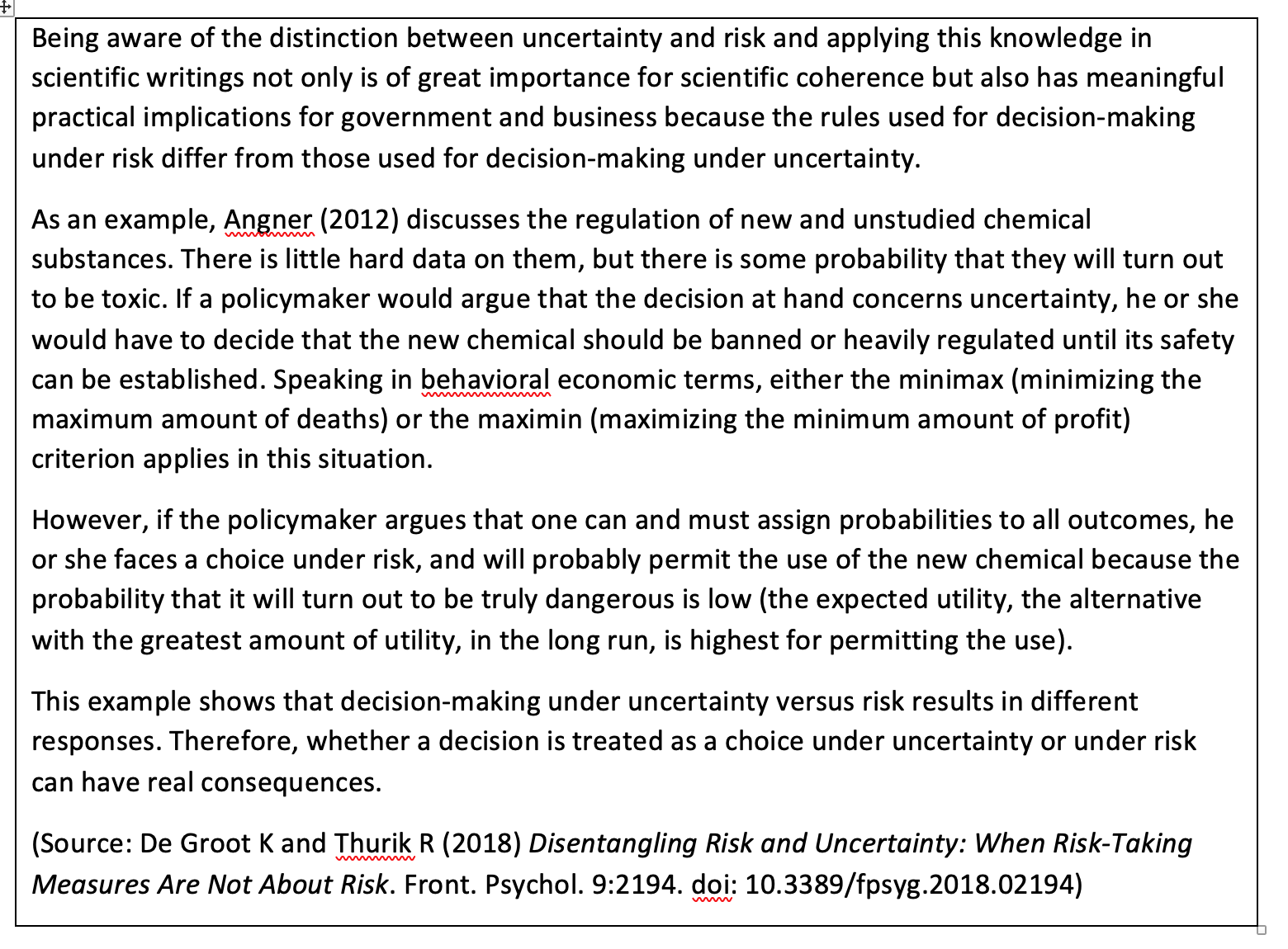 In Part 1 of this series, we looked at the two relevant dimensions for decision-making under certainty, risk, and uncertainty that form the certainty-uncertainty spectrum are:
In Part 1 of this series, we looked at the two relevant dimensions for decision-making under certainty, risk, and uncertainty that form the certainty-uncertainty spectrum are:
- Degree of certainty – It ranges from close to certainty to far from certainty.
- Level of predictability and control – It moves from close to predictability and control to far from predictability and control.
Based on these two dimensions, in this Part2, we will be looking at the three conditions along the certainty-uncertainty spectrum that you will face when making decisions under certainty, risk, and uncertainty.
Depending on the amount and degree of knowledge you must make smart choices, the conditions are:
- Making decisions under certainty (“I can acquire more reliable information”) – On one end of the certainty-uncertainty spectrum, you can acquire all available information and knowledge to reach a certain level of certainty and predictability. This will bring you closer to certainty and closer to predictability and control.
- Making decisions under pure uncertainty (“I don’t know. Let’s work it out together.”) – On the other end of the certainty-uncertainty spectrum, you are ignorant or have absolutely no knowledge, not even about the likelihood of occurrence for an event. Your behavior is purely based on your attitude towards the unknown. You are far from certainty and far from predictability and control. Acknowledging uncertainty and not knowing are the first step in getting closer to what is ‘certain’ or true.
- Making decisions under risk (“I know the probability estimates”) – Somewhere in-between the two ends of the certainty-uncertainty spectrum, you can acquire some information to improve your knowledge and help you decide and take action. You use the best available information to assign subjective probability and consequence estimates for the occurrence of each state. It may not be perfect, but it does the job.
Making decisions under certainty
On one end of the certainty-uncertainty spectrum, a condition of certainty exists when you know with reasonable certainty what the alternatives are, what conditions are associated with each alternative and the outcome of each alternative.
Under conditions of certainty, accurate, measurable, and reliable information and knowledge on which you base your decisions are available to you. The cause-and-effect relationships are known. The future and outcome are highly predictable under conditions of certainty.
Such conditions exist in case of routine and repetitive decisions concerning the day-to-day operations of the business. This is the domain of best or good practices, where everyone knows how to operate. It’s just doing what everyone knows what and how to do. By planning and consulting with subject matter experts you will find several valid solutions.
Knowledge is constantly changing and decaying.
What we know is constantly adapting, changing, or renewing due to advances in science and technology. Everything experienced is new or will be new. Information growth has been and will be exponential.
Driven by the shorter and shorter half-life of information, much we know will decay very quickly. Hence, the need for continuous learning and updating. The problem is that we rarely consider the half-life of information. Even business models have half-lives!
Many people assume that whatever they learned in school remains true years or decades later. Medical students who learned in university that cells have 48 chromosomes would not learn later in life that this is wrong unless they tried to do so.
With the constant changing and decaying of facts, knowledge, and information, there will be more uncertainty than certainty and more unknowns than knowns.
Therefore, there’s not much value in doing a five-year plan for anything when living in uncertainty. If you are constantly revising your predictions, learning from mistakes, and become very good at planning and forecasting, probably the furthest out you can see is about one year.
Time horizons for planning and forecasting have been and will be severely compressed.
But for the rest of us who are not quite that rigorous, who don’t always review your forecasts, and see how right you are and how long you are and why then it’s more likely that the horizon for any ‘accurate’ forecasting is much less than 300 days.
Perhaps, we can only rely on the fast-and-frugal heuristics or rules-of-thumb in adaptive ways to make decisions under risk and uncertainty.
Making decisions under uncertainty
Even the simplest of decisions carry some level of uncertainty.
Conditions of uncertainty exist on the other end of the certainty-uncertainty spectrum when the future and outcome are unpredictable and uncontrollable. Everything is in a state of flux or change. You are not aware of available alternatives, the opportunities, and risks associated with each alternative, the likelihood and consequences of each alternative, and the likelihood and extent of your success.
In making decisions under pure uncertainty, you do not have information and knowledge about the future and outcomes.
There are more unknowns, than knowns. Nobody knows what will happen. There is no possibility of knowing what could occur in the future to alter the outcome of your decision.
You can only make assumptions and guestimates about the situation that provides a reasonable framework for decision-making. You depend on your judgment and intuition to make decisions.
When you admit that “I don’t know” and be open about it, you are less likely to fall into the trap of black-and-white thinking. Admission of uncertainty and what you don’t know can lead to a search for more information. You must first get comfortable with being uncomfortable. Then nudge yourself towards the close to certainty end of the certainty-uncertainty spectrum.
One way to do this is to view decisions made under uncertainty as changeable and reversible. Jeff Bezos of Amazon said that when a decision is reversible, you can make it fast and without perfect information or certainty.
View these changeable and reversible decisions as information that informs future decisions or improvements rather than viewing them as disastrous mistakes or failures.
Other strategies to respond to uncertainty or to reduce uncertainty include:
- Using scenarios to construct alternative narratives or stories that explore more possibilities and probabilities through constructive arguments, networking, collaboration, and cooperation; and information gathering and sharing. Jeff Bezos of Amazon considers 70% certainty to be the cut-off point where it is appropriate to decide. That means acting once you have 70% of the required information, instead of waiting longer. Deciding at 70% certainty and then course-correcting is a lot more effective than waiting for 90% certainty and losing the opportunity.
- Learning through rigorous experimentations and constant failures to uncover what you do know and what you don’t know. Often the best way to probe is to create experiments that are safe to fail and for gathering data. Use minimum viable products to collect the maximum amount of validated learning about your customers or stakeholders with the least amount of effort and potential failures.
Making decisions under risk
Risk implies a degree of uncertainty and an inability to fully control the outcomes or consequences of such an action.
When you have incomplete or some information about the opportunities and risks associated with each alternative, the likelihood and consequences of each alternative, and the likelihood and extent of your success, you are making decisions under a state of risk.
When making decisions under risk, you have some knowledge regarding the likelihood of occurrence of each outcome. When probability can be factored into your decision-making process when making decisions under risk, probability can be a substitute for certainty or complete knowledge.
In making decisions under risk, you can predict the likelihood of a future outcome. Risk means uncertainty for which the probability distribution is known. But when making decisions under uncertainty, the probability distribution is not known.
Decision-makers often lack information. Probability assessment reasonably quantifies this information gap between what is known and what needs to be known for an ‘optimal’ or ‘good’ decision. The probabilistic models and probability are used for protection against adverse uncertainty and exploitation of the unknown.
Risks can be managed while uncertainty is uncontrollable. You can assign a probability to risks events using methods like the ISO 31000 risk management process. While with uncertainty and unknowns, you can’t.
Calculable risk is present when future events occur with some measurable probability. Uncertainty is present when the likelihood of future events is indefinite or incalculable.
If you are certain of the occurrence (or non-occurrence) of an event, you use the probability of one (or zero). Therefore, when making decisions under certainty, a good decision is judged by the outcome alone.
However, if you are uncertain, you would say, “I really don’t know.” Decisions made under risk and uncertainty can only be judged by the quality of the decision-making at the time it is being made, not by the quality of the consequences after the outcome of the decision-making becomes known.
How you frame your situation or problem, either as uncertainty or risk, can make a significant difference to your conclusion and how you approach your decision-making.
Therefore, always strive to move from deciding under uncertainty to deciding under risk by assigning probabilities to outcomes.
Note that the main sources of errors in risky decision-making problems are false assumptions, not having an accurate estimation of the probabilities, relying on expectations, difficulties in measuring the utility function, and forecast errors. These are limitations when making decisions under risk.
For more information on how to plan and execute your strategy under risk, I have written about the nine key principles that relate to the rapid-cycle planning-and-execution approach.
Professional bio
Patrick Ow is a corporate and personal trainer and coach at Practicalrisktraining.com.
As a Chartered Accountant with over 25 years of international risk management experience, he helps individuals and organizations succeed by making better-informed decisions under uncertainty and taking the right opportunities and risks. He has developed PrOACT 31000, a practical yet simple framework based on the world-class PrOACT decision-making framework and the international risk management standard, ISO 31000.
Patrick has authored several eBooks including Strategic Risk Management Reimagined: How to Improve Performance and Strategy Execution and Things Parents Wish They Knew Earlier: The Family Risk Management Handbook.
